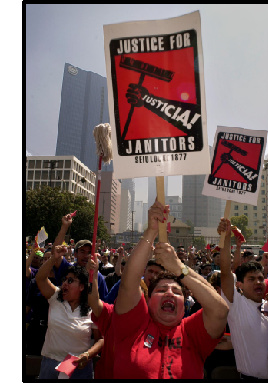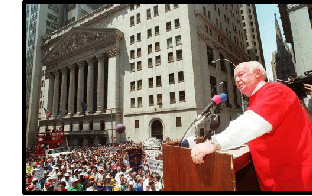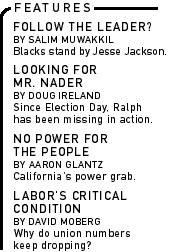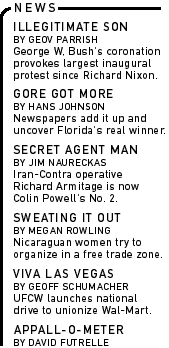|
When John Sweeney became the president of the AFL-CIO in 1995,
he set organizing a million new members a year as the labor movement's
top priority. Without a turnaround in the four-decade-long decline
in union strength, organized labor faced not only losing its power
in bargaining and politics, but disappearing altogether. Last year,
when the percentage of the work force in unions failed to drop for
the first time since 1975, there was hope that the long slump had
bottomed out.
That celebration was short-lived. In January, the Bureau of Labor
Statistics announced that in 2000 the number of union members had
dropped once again to 16.3 million, representing only 13.5 percent
of the work force, a decline of 0.4 percent from 1999. The character
of the labor movement also continues to change: 37.5 percent of
government workers are organized (a slight increase from last year),
but only 9 percent of the private sector work force now belongs
to a union. While emphasizing that there was still a net growth
of 150,000 members over the past three years, AFL-CIO organizing
director Mark Splain acknowledges that "clearly it's not good news
that the numbers are going in the wrong direction."
Although there are many reasons for the renewed decline, the central
problem is that,
 |
|
Despite energized campaigns
like the
janitors' strike in Los Angeles, overall
union numbers keep falling.
DAVID McNEW/NEWSMAKERS
|
despite strong efforts by a few unions, there is still only a spotty
and superficial commitment to organizing at all levels of the labor
movement. "We think there's a crisis," says Andy Stern, president
of the Service Employees Union (SEIU)--one of the most aggressive
organizers in the labor movement--and co-chairman of the AFL-CIO Executive
Council Organizing Committee. "What I'm most concerned about is that
there needs to be more of a sense of crisis from the AFL-CIO and throughout
the labor movement."
The decline of members last year probably reflects heavy job losses
in manufacturing, where union density is relatively high, that were
obscured by overall low unemployment figures. Also unions diverted
much money and staff to politics this year rather than organizing.
There were also some big wins in 1999, such as the 70,000 home health
care workers in Los Angeles, that reflected many years of previous
organizing. The AFL-CIO claims that 400,000 new workers were organized
last year (although the running tally in its "Work In Progress"
newsletter identified only 160,000) compared with 600,000 in 1999
and 500,000 in 1998. But several experts privately express doubts
about the reliability of those numbers.
A few unions are widely acknowledged as organizing leaders, such
as SEIU, UNITE, the Hotel Employees (HERE) and the Communications
Workers (CWA). Other unions that have made major new commitments
to organizing include AFSCME (public workers), the Steelworkers,
the Autoworkers and the Carpenters. But even in these unions, there
isn't universal commitment. For example, CWA locals have resisted
international efforts to increase spending on organizing, and only
a few AFSCME district councils, such as in Illinois, have made organizing
a top priority.
Much of the problem reflects internal union politics: Officials
succeed by catering to members, who often must be persuaded to spend
their dues money on expensive, risky efforts to recruit new members
rather than providing services for themselves. Since nearly three-fourths
of union funds are controlled by often autonomous local unions,
even a committed international union president may have limited
influence. Although last summer the AFL-CIO agreed to hold unions
more accountable to membership goals, the federation has no power
over affiliated unions. Furthermore, despite its continual emphasis
on organizing, the AFL-CIO and its leaders often send the message
that political work is even more important.
When Sweeney came into office, the best estimates were that few
unions spent more than 5 percent of their budgets on organizing.
With a few exceptions--again most notably the SEIU--very few unions
reach the AFL-CIO recommended level of spending 30 percent of their
budgets on organizing. "There are only a very few unions at the
national or local level that have made a dramatic changes," says
Richard Bensinger, the former AFL-CIO organizing director who is
now a consultant to several unions. "Most union commitment to organizing
is still at the level of rhetoric. You can see substantial growth
and commitment in those few, but there's next to nothing in many
others."
The issue is partly money. "There's no way to do this on the cheap,"
Bensinger says. "The law is too weak and employers too vicious to
think we can get by inexpensively." But the more fundamental issue
is changing the internal culture of the labor movement. Starting
with Bensinger's tenure, the AFL-CIO has encouraged union officials
and staff to develop a new outlook on their work. Unions like HERE,
for example, extensively train union stewards to mobilize members
and handle grievances on the job, freeing staff to focus more on
organizing new members with the help of newly energized member volunteers.
This represents a dramatic change from the old "insurance" model
of unions, where business agents handle individual union members'
problems.
Cultural change also demands a new organizing strategy. First,
the best organizing unions have moved away from simply responding
to "hot shop" calls from agitated workers or desperately seeking
new members in seemingly easy targets outside their traditional
realms. Unions like SEIU and HERE build on their strengths to develop
power in particular industries (the two have even swapped locals).
Against great resistance, SEIU's Stern is pushing hard for all unions
to pursue more clearly focused strategies.
Successful unions also approach organizing as a task of building
a union at the
 |
|
AFL-CIO President John Sweeney
addresses
workers at an "America Needs a Raise"
rally on Wall Street in 1996.
STAN HONDA/AFP
|
workplace even before it is recognized, starting with the creation
of an internal committee of dedicated workers who do most of the organizing.
Union organizers can't succeed with old tactics of handing out leaflets
at plant gates. They must pursue more aggressive tactics such as holding
solidarity days at work, surveying workers about their needs, conducting
actions on the job, or involving the community--including clergy,
elected officials, community groups and the press--in support of workers
who are trying to organize. According to Cornell University researcher
Kate Bronfenbrenner, unions that used five or more of these "union
building" tactics as part of their organizing efforts in 1998 and
1999 were 30 percent more likely to win an NLRB representation election
than unions that did not. In the long run, these tactics are also
likely to build stronger unions, but they have been adopted mainly
because unions needed to counter intense employer opposition.
Consider the case of Certech, a 500-worker unit of the global Carpenter
Technology Corporation that manufactures advanced ceramics for the
auto, aerospace and electric power industries in northern New Jersey.
In 1999 workers from the plant, which primarily employs immigrant
women from Central America, contacted UNITE for their third try
to form a union. The company responded, as usual, with a campaign
of threats, including moving the company to Mexico, bribes and intimidation,
even firing seven union supporters. Last March the workers voted
against unionization.
But the union worked with the core of committed union members to
continue the fight with protests, leafleting and mobilization of
support from clergy, local politicians, other unions and community
groups. That support gave workers courage to testify at hearings
on 70 charges of unfair labor practices that the union brought to
the National Labor Relations Board. As the testimony continued into
the third week, the company called and said it was ready to negotiate
a contract, which was signed at the end of January. The outside
support was essential, but the key was a well-organized group of
workers on the job. "We put our heart into this campaign," says
regional organizing director Rhina Molina, "but nothing can be done
unless the workers decide they want to do it."
At a time when surveys show more than a third of unorganized workers
would like to join a union, the chief obstacle to unionization remains
employer opposition, which exploits labor laws that have grown weaker
over the years. In a scathing report issued last fall, Human Rights
Watch concluded that American labor law fell far short of international
standards. "Many workers who try to form and join trade unions to
bargain with their employers are spied on, harassed, pressured,
threatened, suspended, fired, deported or otherwise victimized in
reprisal for their exercise of the right to freedom of association,"
the group reported.
The problem has only grown worse with globalization. Bronfenbrenner
has found that more than half of employers threatened to close all
or part of the work site during organizing drives, nearly double
the rate of threats in the late '80s. In the most mobile industries,
like manufacturing, 68 percent of employers threatened to move during
organizing drives; those threats cut union wins by about 40 percent.
Although the threats (made as often by financially strong companies
as weak ones) were often idle, 15 percent of plants where unions
won recognition actually did shut down within two years, triple
the rate in the late '80s.
The fierce level of employer opposition still chills union organizing,
despite improved strategies of the best unions. Unions now win more
than half of all NLRB elections (53 percent in fiscal year 1999),
but the number of elections held and workers eligible to vote remains
below even what it was in the late '80s. Partly that reflects a
shift away from NLRB elections to other methods, such as pressuring
companies to recognize the union when a majority of workers have
signed union cards. Yet the overall picture remains grim: Roughly
one-third of the time, unions withdraw even before an election is
held, as employer opposition destroys union support. Even after
winning an election, only 60 percent of private sector workers typically
secure a first contract.
Union organizing increasingly focuses on the nonprofit-private
and public-service sectors, where win rates are much higher (often
60 to 70 percent in sectors like health care and finance) because
opposition is usually less fierce. With the growing influence of
globalization, unions are devoting less effort to organizing in
manufacturing, where they win about 42 percent of elections overall--but
only about 31 percent of elections in the most global companies,
according to Bronfenbrenner. Not surprisingly, multinational companies
are far more likely to threaten to close and move than nationally
based firms.
Unions like CWA and HERE have led the effort to reduce employer
opposition by using their bargaining or political clout to win agreements
from companies to stay neutral during organizing drives. But unions
have also used their political leverage to make sure that publicly
supported local development deals provide for labor peace--no strikes
during organizing in exchange for employer neutrality. California
last year also approved legislation mandating that businesses not
use state funds to oppose unionization. Unions won about two-thirds
of organizing campaigns with neutrality agreements, according to
a study published last year.
It is also possible to curtail employer tactics in less formal
ways. The AFL-CIO has encouraged central labor councils to promote
"the right to choose a voice at work" through public actions. Stern
wants the AFL-CIO to increase pressure on officials who are elected
with labor support to take concrete actions to support union organizing
efforts as well as push for local and state legislation, such as
reversing right-to-work laws and passing legislation prohibiting
public money from being used to fight unions. Splain adds, "The
action for us will be at the local and state level where union density,
strength, ties to the community are pretty good, like Los Angeles."
President Clinton did little to help union organizing, and there
is no prospect for federal legislation to aid organizing in the
near future under Bush and a Republican Congress. Human Rights Watch
recommended a long, reasonable list of reforms that would strengthen
workers rights in the United States, but the greatest value of the
report is in highlighting this country's failure to live up to established
international law and human rights treaties. In a related effort,
the Labor Party has launched a campaign to ground workers rights
in the guarantee of First Amendment rights of free speech and association
at work and in the constitutional prohibition of involuntary servitude,
rather than a focus on reforming existing labor law, which is based
on the federal government's power to regulate interstate commerce.
Ultimately, the most effective campaign for workers rights would
be massive organizing drives--some focused on a particular corporation,
others on a regional industry or other target--that would combine
all of the demonstrated elements of a successful organizing campaign
with a high-profile political and community fight to guarantee workers
rights. It is unlikely that unions will break out of the cage formed
by the law, employer power and globalization until the crisis of
the labor movement becomes a social crisis as well. But first the
labor movement must recognize its own critical condition and be
willing, as the civil rights movement was, to create a social crisis
if workers rights are not respected. 
|





